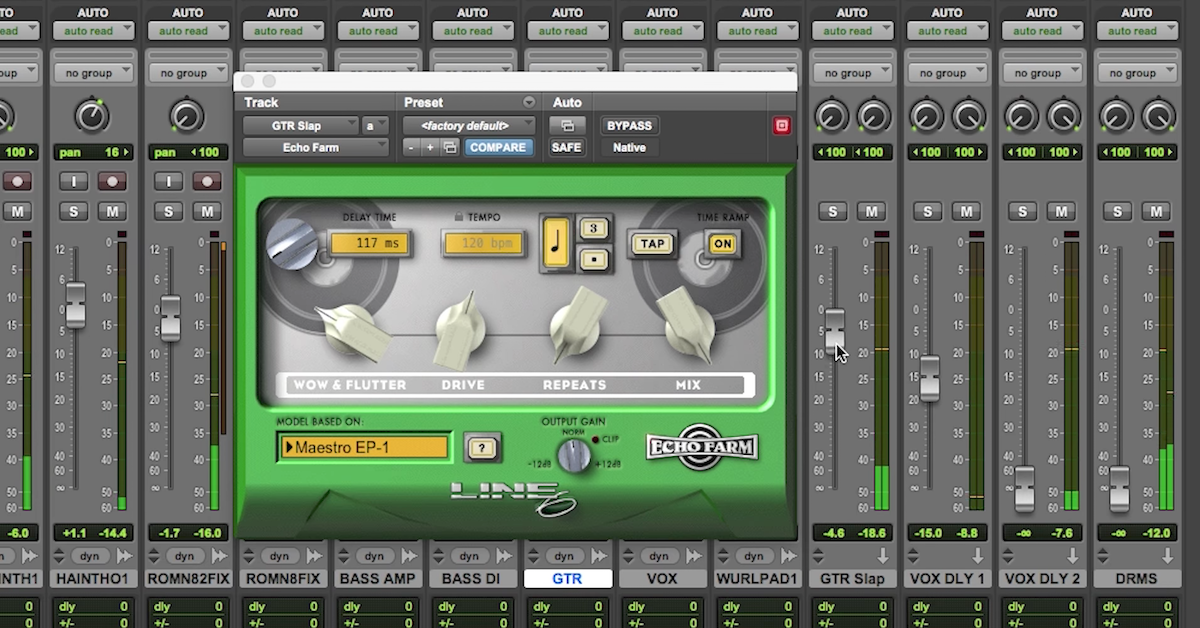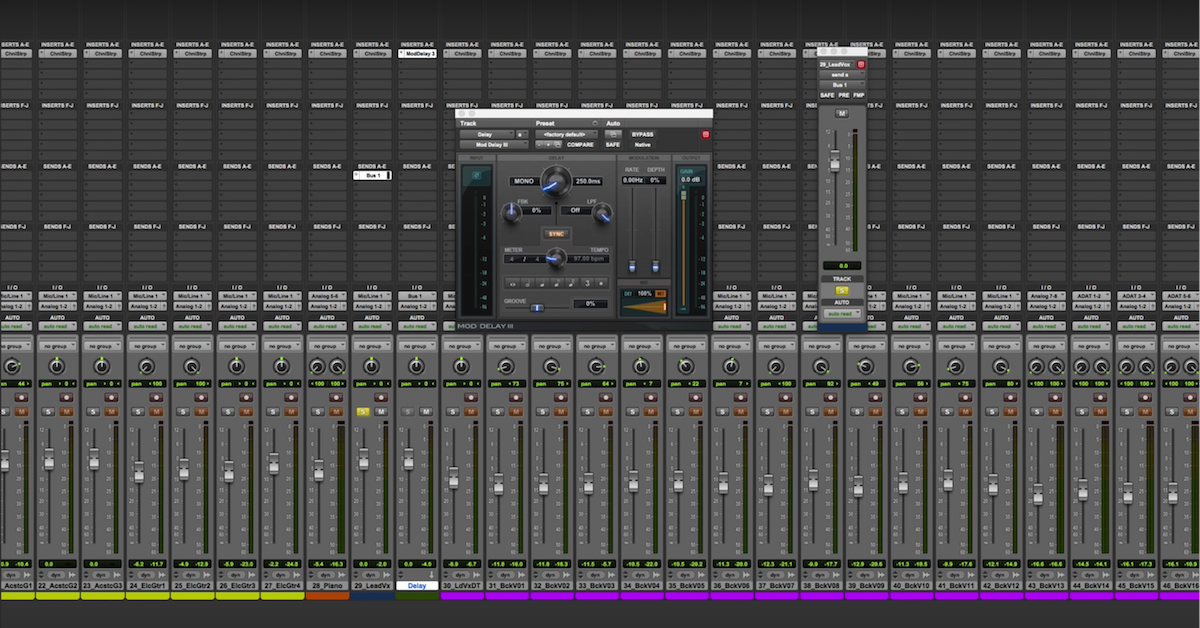Classic Delay Effects and How to Use Them in Your Mixes [Video]
Recently, it’s been made available for native Pro Tools systems, and it’s really a timeline of classic delay sounds. The original TDM version of Echo Farm was used on hundreds, if not thousands of commercial recordings, and it also was used on many major hits.
I’d like to walk you through the different progression of technology of delay, and how delay has been used within the signal path of guitar, mixing, and in the studio control room environment.
We’re going to be checking out a few key sounds of each era.
So let’s first take it back to 1963 with the Maestro EP-1. This unit used quarter inch tape, and it was also powered by vacuum tubes. In general, this would’ve been a unit that went by the guitar amp, or on top of the guitar amp. It was a fairly large unit. It was much larger than an average guitar pedal that we’re used to seeing on a guitar pedalboard.
Now, the original EP-1 didn’t have an adjustment for wow and flutter, but it’s a great addition for EchoFarm. It’s a really cool way to adjust and shape the sound of the delay.
So let’s have a listen and see how it sounds on some guitar.
[guitar with Maestro EP-1]
So this is a fairly fast delay here. Of course, we could go longer with this if we wanted to. The max time was 650 milliseconds. Now, thanks to the world of plugins, Line 6 has taken the liberty at making that max at 2500 milliseconds, so you can really get creative with this.
Now, I should also mention that this is in the signal path before the amp, so we have the guitar dry and DI signal, we have a compressor, the Echo Farm, and then our guitar amp simulator. This is mimicking how the real world would be setup with a guitar going into the unit and then out to the guitar amp.
Now of course, an all time favorite is the Space Echo. We actually have several different options here. Let’s talk a little bit about the settings on this emulation. So with the setting on one, we’re emulating just a single tape head, but I find this is actually a much more cleaner setting than some of these others.
Check it out.
[vocals and acoustic, with delay]
Now the swell patterns.
[vocals and acoustic, adjusting swell]
Swell number 2.
[vocals and acoustic, swell 2]
Swell number 3.
[vocals and acoustic, swell 3]
Then from here, we have some different swell patterns, which is a combination of four different tape heads that were emulated off the Space Echo.
[vocals and acoustic, swell patterns]
Okay, next up we have the DM-2. This is a just classic pedal. Key word is pedal. Not entire unit, you know, with the Space Echo, the EP-1, the EP-3, these were fairly sizeable units, but now, we have something that is actually more reliable than the tape units. It can run on batteries, and it can fit on a pedal board.
So we have a total shift in the usability for guitarists and performers. Again, this is something that’s a part of the signal path, it’s a part of the source. Now, I know a lot of people, they think of these analog delays as having warm repeats. They definitely do, but they are still much more precise than the tape emulations that are in Echo Farm, and so here, I have dialed in a very kind of rhythmic fashion, the DM-2 going on some choppy guitar. It really takes this performance to a whole other level.
[guitar with delay]
Another great delay in the pedal category is the Deluxe Memory Man. It’s really wide sounding, very musical, very easy to use delay. Let’s check that out.
[song with Memory Man delay]
Okay, so from here, delay became no longer just an effects for the guitar, but it also became a control room based effect that was used on vocals, drums, about anything that was appropriate in the mix environment. So we have the TC Electronic 2290, which is a rack mount based delay.
Now here, in Echo Farm, it’s called the Dynamic Delay, and it’s a great way to apply some delay to vocals without it getting in the way and riding up on that dry vocal sound. So the idea is instead of having to manually automate all of this, you can set the settings to stay out of the way of your dry vocal.
[vocals with dynamic delay]
So the idea here is that the dry vocal is kept fairly well preserved in the front of our mix, and then as the dry vocal stops, then the delay senses that, and it raises up the volume of the repeats.
So one plugin I really enjoy is the Auto-Volume Echo. I think it does it very, very well, and it’s kind of a cross between the EP-1 and the Dynamic Delay. We have the wow and the flutter, but then we have a swell time, so it keeps the delay out from our dry vocal, but then it also has a — it has that wow and flutter that has that imperfect delay repeat sound.
Let’s check it out.
[mix with Auto-Volume Echo]
So we can hear that in the spaces, we have a repeat that is kind of swelling in, and going out to the side. Now, this wow and flutter is pretty cool. I mean, without it, it kind of goes right down the middle. We crank up the wow and flutter and it kind of goes out to the sides.
[mix, adjusting wow and flutter]
So this is a little bit different than that Dynamic Delay based on the 2290, where it’s really a smart delay with a threshold and amount of ducking. This is more about the swell time, but you can really dial those in to the speed of the song, and really get the results that you need.
One great feature for all these emulations is the ability to tempo sync with a DAW.
Okay, so I really think that Echo Farm is a great tool for adding some flavor into some mixes. So again, it’s now available for native Pro Tools systems, meaning that you can open projects created on a TDM system without any issue.
Now, if you’d like to see any more tutorials that I do, I’m at creativesoundlab.tv. Also at sonicscoop.com, and a big thanks to Line 6. We’ll talk to you soon.





